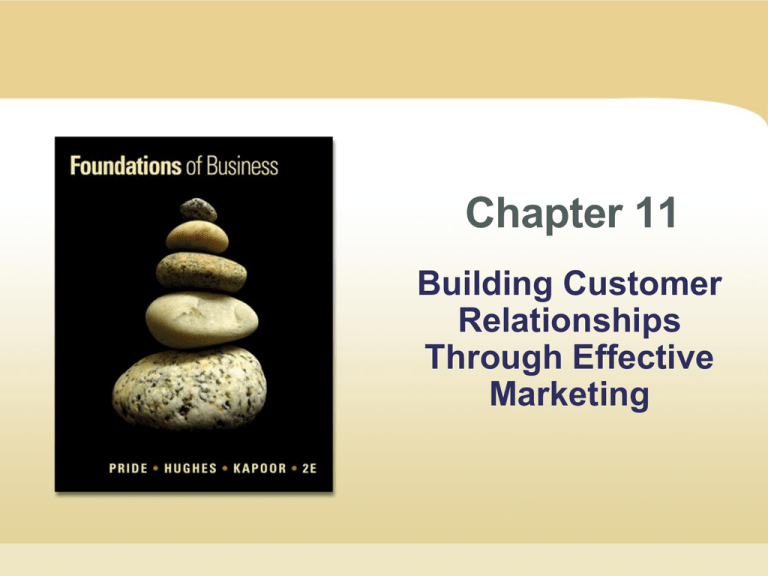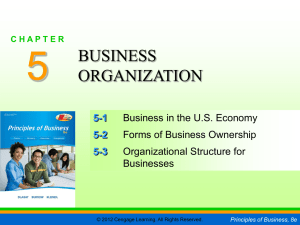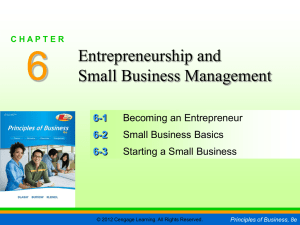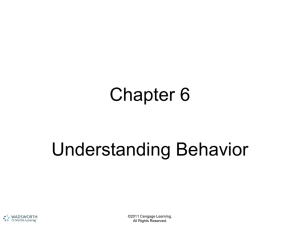
Chapter 11
Building Customer
Relationships
Through Effective
Marketing
Learning Objectives
1.
Understand the meaning of marketing and the importance of management
of customer relationships.
2.
Explain how marketing adds value by creating several forms of utility.
3.
Trace the development of the marketing concept and understand how
it is implemented.
4.
Understand what markets are and how they are classified.
5.
Identify the four elements of the marketing mix and be aware of their
importance in developing a marketing strategy.
6.
Explain how the marketing environment affects strategic market planning.
7.
Understand the major components of a marketing plan.
8.
Describe how market measurement and sales forecasting are used.
9.
Distinguish between a marketing information system and marketing research.
10. Identify the major steps in the consumer buying decision process and the sets
of factors that may influence this process.
Copyright © Cengage Learning. All rights reserved.
Chapter 11 | Slide 2
Marketing
…an organizational function and a set of
processes for creating, communicating,
and delivering value to customers and for
managing customer relationships in ways that
benefit the organization and its stakeholders.
Copyright © Cengage Learning. All rights reserved.
Chapter 11 | Slide 3
Table 11.1: Major Marketing Functions
Copyright © Cengage Learning. All rights reserved.
Chapter 11 | Slide 4
Exchange Between Buyer and Seller
Source: William M. Pride and O. C. Ferrell, Marketing: Concepts and Strategies, 15th ed.
(Mason, Ohio: South-Western/Cengage Learning, 2010). Adapted with permission.
Copyright © Cengage Learning. All rights reserved.
Chapter 11 | Slide 5
Relationship Marketing
…establishing long-term, mutually satisfying
buyer-seller relationships.
Successful marketers respond to customer needs
and strive to continually increase value to
buyers over time.
Copyright © Cengage Learning. All rights reserved.
Chapter 11 | Slide 6
Customer Relationship Marketing
…using information about customers to
create marketing strategies that develop and
sustain desirable customer relationships.
Copyright © Cengage Learning. All rights reserved.
Chapter 11 | Slide 7
Customer Lifetime Value
…a combination of purchase frequency,
average value of purchases, and brandswitching patterns over the entire span of a
customer’s relationships with a company.
Copyright © Cengage Learning. All rights reserved.
Chapter 11 | Slide 8
Utility
…the ability of a good or service to
satisfy a human need.
Copyright © Cengage Learning. All rights reserved.
Chapter 11 | Slide 9
Types of Utility
Form: converting
production inputs into
finished products
Place: making a product
available at a location
where customers wish to
purchase it
Time: making a product
available when customers
wish to purchase it
Possession: transferring
title (or ownership) of a
product to a buyer
Copyright © Cengage Learning. All rights reserved.
Chapter 11 | Slide 10
Figure 11.1: Types of Utility
Copyright © Cengage Learning. All rights reserved.
Chapter 11 | Slide 11
Marketing Concept
…a business philosophy that a firm should
provide goods and services that satisfy
customers’ needs through a coordinated
set of activities that allows the firm to
achieve its objectives.
Copyright © Cengage Learning. All rights reserved.
Chapter 11 | Slide 12
Table 11.2: Evolution of
Customer Orientation
Copyright © Cengage Learning. All rights reserved.
Chapter 11 | Slide 13
Evolution of the Marketing Concept
Production Orientation
1850
Sales Orientation
1900
Marketing Orientation
1950
2000
Source: Adapted from William M. Pride and O.C. Ferrell, Foundations of Marketing, 3rd
ed., © 2009 by Houghton Mifflin Company. All rights reserved.
Copyright © Cengage Learning. All rights reserved.
Chapter 11 | Slide 14
Implementing Marketing Concept
Obtain information
Determine needs
Determine how needs are
currently satisfied
Learn how products might
be improved
Find out opinions customers
have of firm and marketing efforts
Use information to pinpoint
specific needs and potential
customers
Copyright © Cengage Learning. All rights reserved.
Chapter 11 | Slide 15
Mobilize Marketing Resources
Provide product
Price product
Promote product
Distribute product
Obtain information
Copyright © Cengage Learning. All rights reserved.
Chapter 11 | Slide 16
Market
…a group of individuals or organizations, or
both, that need products in a given category
and that have the ability, willingness, and
authority to purchase such products.
Copyright © Cengage Learning. All rights reserved.
Chapter 11 | Slide 17
Market Classifications
Business-to-Consumer (B2C)
Business-to-Business (B2B)
Copyright © Cengage Learning. All rights reserved.
Chapter 11 | Slide 18
Business-to-Consumer Markets
…consist of purchasers and/or household
members who intend to consume or benefit
from the purchased products and who do not
buy products to make profits.
Copyright © Cengage Learning. All rights reserved.
Chapter 11 | Slide 19
Business-to-Business Markets
…are grouped broadly into producer,
reseller, governmental, and institutional
categories…. They purchase specific kinds
of products for use in making other products,
for resale, or for day-to-day operations.
Copyright © Cengage Learning. All rights reserved.
Chapter 11 | Slide 20
B2B Markets
Producer : buys certain products to use in
manufacture of other products
Reseller: buys finished products and sells
them for profit
Governmental: buys goods and services to
maintain internal operations and to provide
products to citizens
Institutional: buys goods for goals unrelated
to profit, market share, or return on investment
Copyright © Cengage Learning. All rights reserved.
Chapter 11 | Slide 21
Marketing Strategy
…a plan that will enable an organization to
make the best use of its resources and
advantages to meet its objectives.
Copyright © Cengage Learning. All rights reserved.
Chapter 11 | Slide 22
Using the Internet
• The American Marketing Association’s
website is an excellent resource for marketing
information.
http://www.marketingpower.com
Copyright © Cengage Learning. All rights reserved.
Chapter 11 | Slide 23
Parts of Marketing Strategy
Select/analyze target market
Create/maintain appropriate marketing mix
Copyright © Cengage Learning. All rights reserved.
Chapter 11 | Slide 24
Marketing Mix
…a combination of product, price,
distribution, and promotion developed
to satisfy a particular target market.
Copyright © Cengage Learning. All rights reserved.
Chapter 11 | Slide 25
Target Market
…a group of individuals or
organizations, or both, for which a firm
develops and maintains a marketing
mix suitable for the specific needs and
preferences of that group.
Copyright © Cengage Learning. All rights reserved.
Chapter 11 | Slide 26
Marketing Managers
Examine potential markets for possible effect
on firm’s sales, costs, and profits
Determine if organization has the resources
to produce a marketing mix that meets the
needs of a target market
Determine if satisfying those needs is
consistent with firm’s objectives
Analyze competitors
Copyright © Cengage Learning. All rights reserved.
Chapter 11 | Slide 27
Approaches of Selecting Target Market
Undifferentiated
Company designs a
single marketing mix and
directs it at the entire
market for a particular
product
Market segmentation
Company divides a
market into segments and
directs marketing mix at
particular segment or
segments rather than the
total market
Copyright © Cengage Learning. All rights reserved.
Chapter 11 | Slide 28
Market Segment
…a group of individuals or organizations
within a market that shares one or more
common characteristics.
Copyright © Cengage Learning. All rights reserved.
Chapter 11 | Slide 29
Figure 11.2: Selecting
Target Markets
The letters in each target market
represent potential customers.
Customers that have the same
letters have similar
characteristics and similar
product needs.
Copyright © Cengage Learning. All rights reserved.
Chapter 11 | Slide 30
Table 11.3: Common Bases of
Market Segmentation
Source: William M. Pride and O. C. Ferrell, Marketing: Concepts and Strategies, 15th ed.
(Mason, Ohio: South-Western/Cengage Learning, 2010). Adapted with permission.
Copyright © Cengage Learning. All rights reserved.
Chapter 11 | Slide 31
Advertisers’ Classification of Audiences
Age
Name
(2003)
Needs
Influencer
Millennials
<25
Tech Savvy
Grew up in
prosperous
times
25–38
Media Savvy
Grew up in
economic
downturn
Boomers
39–58
Avid Consumers
Deny aging
process
Matures
57+
Gen X-ers
Practical, pragmatic
Money
conscious
MediaKnowAll, “Audience Research”, http://www.mediaknowall.com/Advertising/research.html
Copyright © Cengage Learning. All rights reserved.
Chapter 11 | Slide 32
Figure 11.3: The Marketing Mix and
the Marketing Environment
Copyright © Cengage Learning. All rights reserved.
Chapter 11 | Slide 33
Product Decisions
Design
Brand Name
Packaging
Warranties
Copyright © Cengage Learning. All rights reserved.
Chapter 11 | Slide 34
Pricing Decisions
Base Price
Spotlight
Discounts
Goals
• Maximize profit
• Make room for
new models
Source: Bayer Consulting for Deloitte LLP survey of 1,006 people ages 17 to 28.
Copyright © Cengage Learning. All rights reserved.
Chapter 11 | Slide 35
Distribution Decisions
Transportation
Storage
Selection of Intermediaries
• Number of levels
• Width of distribution
Copyright © Cengage Learning. All rights reserved.
Chapter 11 | Slide 36
Promotion Decisions
Advertising
Personal Selling
Sales Promotion
Public Relations
Copyright © Cengage Learning. All rights reserved.
Chapter 11 | Slide 37
Controllable Elements
of Mix Can Also Be Varied for...
Organizational goals
Marketing goals
Target markets
Copyright © Cengage Learning. All rights reserved.
Chapter 11 | Slide 38
Forces of External Marketing Mix
Economic
Sociocultural
Political
Competitive
Legal & regulatory
Technological
Copyright © Cengage Learning. All rights reserved.
Chapter 11 | Slide 39
Marketing Plan
…a written document that specifies
an organization’s resources, objectives,
strategy, and implementation and control
efforts to be used in marketing a specific
product or product group.
Copyright © Cengage Learning. All rights reserved.
Chapter 11 | Slide 40
Marketing Plan
Describes firm’s current position
Establishes marketing objectives for product
Specifies how the organization will attempt to
achieve these objectives
Time frame
• Short-range = 1 year or less
• Medium-range = 1 to 5 years
• Long-range = 5+ years
Copyright © Cengage Learning. All rights reserved.
Chapter 11 | Slide 41
Marketing Plan Is Used for...
Communication among employees
Assignment of responsibilities/tasks
Schedules for implementation
How resources allocated
Monitor/evaluate performance
Copyright © Cengage Learning. All rights reserved.
Chapter 11 | Slide 42
Table 11.4: Components of Marketing Plan
Source: William M. Pride and O. C. Ferrell, Marketing: Concepts and Strategies, 15th ed.
(Mason, Ohio: South-Western/Cengage Learning, 2010). Reprinted with permission..
Copyright © Cengage Learning. All rights reserved.
Chapter 11 | Slide 43
Sales Forecast
…an estimate of the amount of a product
that an organization expects to sell during a
certain period of time based on a specified
level of marketing effort.
Copyright © Cengage Learning. All rights reserved.
Chapter 11 | Slide 44
Forecasting Methods
Executive judgments
Surveys of buyers/sales personnel
Time-series analyses
Correlation analyses
Market tests
Copyright © Cengage Learning. All rights reserved.
Chapter 11 | Slide 45
Marketing Information System
…a system for managing marketing
information that is gathered continually from
internal and external sources.
Copyright © Cengage Learning. All rights reserved.
Chapter 11 | Slide 46
Sources of Information
Internal
Sales figures
External
Organization’s suppliers
Product/marketing
costs
Intermediaries
Inventory levels
Competitors’ activities
Activities of sales
force
Copyright © Cengage Learning. All rights reserved.
Customers
Economic conditions
Chapter 11 | Slide 47
Information Can Include
Daily sales reports
Forecasts of sales/buying trends
Reports on changes in market share
Copyright © Cengage Learning. All rights reserved.
Chapter 11 | Slide 48
Marketing Research
…the process of systematically gathering,
recording, and analyzing data concerning a
particular marketing problem.
Copyright © Cengage Learning. All rights reserved.
Chapter 11 | Slide 49
Table 11.5: The Six Steps of Market Research
Copyright © Cengage Learning. All rights reserved.
Chapter 11 | Slide 50
Technology and Marketing Information
Database
Single-Source Data
Online Information Services
Internet
• Nielsen
• Advertising Age
Intranet
Copyright © Cengage Learning. All rights reserved.
Chapter 11 | Slide 51
Table 11.6: Internet Sources
of Marketing Information
Source: William M. Pride and O. C. Ferrell, Marketing: Concepts and Strategies, 15th ed.
(Mason, Ohio: South-Western/Cengage Learning, 2010). Reprinted with permission.
Copyright © Cengage Learning. All rights reserved.
Chapter 11 | Slide 52
Buying Behavior
…the decisions and actions of people
involved in buying and using products.
Copyright © Cengage Learning. All rights reserved.
Chapter 11 | Slide 53
Consumer Buying Behavior
…the purchasing of products for
personal or household use, not for
business purposes.
Copyright © Cengage Learning. All rights reserved.
Chapter 11 | Slide 54
Figure 11.4: Consumer Decision
Process and Influences
Copyright © Cengage Learning. All rights reserved.
Chapter 11 | Slide 55
Business Buying Decision Process and
Possible Influences on the Process
Source: William M. Pride and O. C. Ferrell, Marketing: Concepts and Strategies, 13th ed.
Copyright © 2006 by Houghton Mifflin Company. Adapted with permission.
Copyright © Cengage Learning. All rights reserved.
Chapter 11 | Slide 56
Personal Income
…the income an individual receives from
all sources less the Social Security taxes
the individual must pay..
Copyright © Cengage Learning. All rights reserved.
Chapter 11 | Slide 57
Disposable Income
…personal income less all additional
personal taxes.
Copyright © Cengage Learning. All rights reserved.
Chapter 11 | Slide 58
Discretionary Income
…disposable income less savings
and expenditures on food, clothing,
and housing.
Copyright © Cengage Learning. All rights reserved.
Chapter 11 | Slide 59
Business Buying Behavior
…the purchasing of products by
producers, resellers, governmental
units, and institutions.
Copyright © Cengage Learning. All rights reserved.
Chapter 11 | Slide 60
Business Buyers
Consider
• Quality
• Price
• Service provided
Usually
• Better informed
• Buy in larger quantities
Copyright © Cengage Learning. All rights reserved.
Chapter 11 | Slide 61
Business Buying Occurs Through...
Description
Inspection
Sampling
Negotiation
Copyright © Cengage Learning. All rights reserved.
Chapter 11 | Slide 62
Chapter Quiz
1. The utility created by transferring title of a product to the buyer
is called __________ utility.
a)
b)
c)
d)
e)
form
time
production
place
possession
Copyright © Cengage Learning. All rights reserved.
Chapter 11 | Slide 63
Chapter Quiz
2. J.C. Penney is considered to be a member of which type
of market?
a)
b)
c)
d)
e)
Business-to-business
Reseller
Consumer
Producer
Institutional
Copyright © Cengage Learning. All rights reserved.
Chapter 11 | Slide 64
Chapter Quiz
3. The ingredient of the marketing mix concerned with product
design, brand names, packaging, and warranties is
a)
b)
c)
d)
e)
pricing.
quality.
product.
distribution.
promotion.
Copyright © Cengage Learning. All rights reserved.
Chapter 11 | Slide 65
Chapter Quiz
4. All of the following are true of marketing plans except that
they should
a)
b)
c)
d)
e)
not be modified.
include details of task scheduling.
specify task objectives.
describe the firm’s current situation.
focus on a particular product or product group.
Copyright © Cengage Learning. All rights reserved.
Chapter 11 | Slide 66
Chapter Quiz
5. In this chapter, MIS refers to _________ system.
a)
b)
c)
d)
e)
merged information
major information
marketing information
market influential
minor information
Copyright © Cengage Learning. All rights reserved.
Chapter 11 | Slide 67








